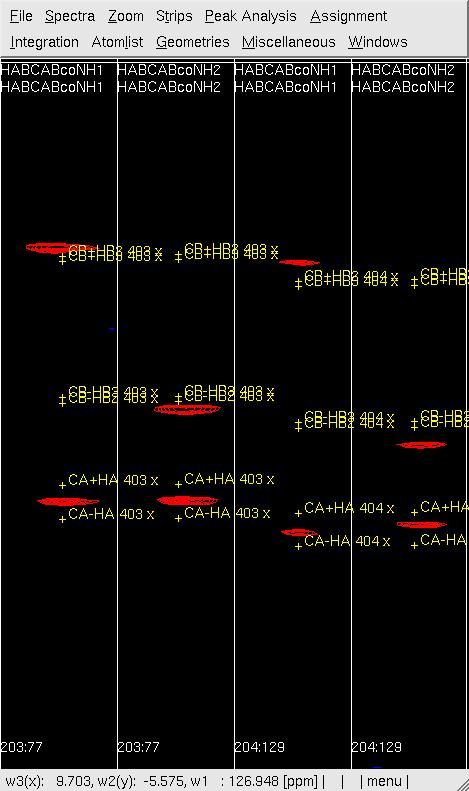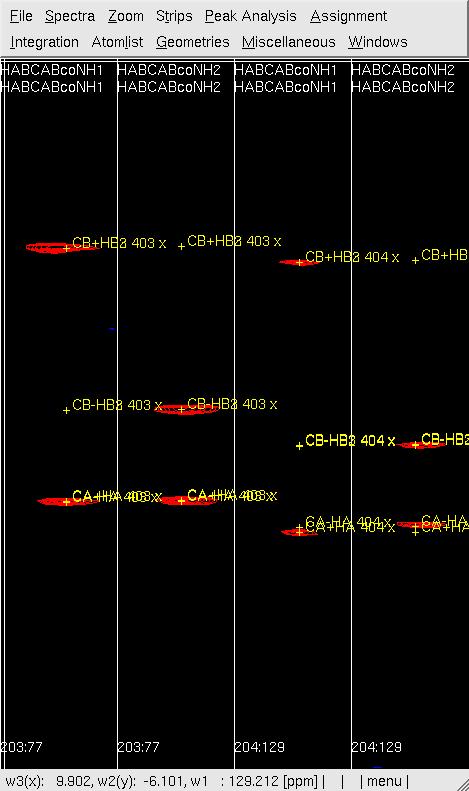HA and HB Assignment with GFT in XEASY: Difference between revisions
Jump to navigation
Jump to search
No edit summary |
No edit summary |
||
| Line 17: | Line 17: | ||
##In XEASY, use <tt>cp</tt> to display the spectrum as a countour plot; use <tt>fp</tt> or <tt>bp</tt> to step through the planes until you see representative peaks for setting the coutour levels; use <tt>pm</tt> to display [w1(13C/1H),w2(15N)]-planes; use <tt>mr</tt> to accurately position the peaks along w2(15N); use <tt>pm</tt> to display [w2(15N),w3(1HN)]-planes. | ##In XEASY, use <tt>cp</tt> to display the spectrum as a countour plot; use <tt>fp</tt> or <tt>bp</tt> to step through the planes until you see representative peaks for setting the coutour levels; use <tt>pm</tt> to display [w1(13C/1H),w2(15N)]-planes; use <tt>mr</tt> to accurately position the peaks along w2(15N); use <tt>pm</tt> to display [w2(15N),w3(1HN)]-planes. | ||
##In XEASY, use <tt>se</tt> and <tt>gs</tt> to create strips from entries of loaded PeakList and display, for example, ten at once; navigate through the strips by using <tt>fs</tt> and <tt>bs</tt>; use <tt>pw</tt> to set the '''assignment y''' in the peak window so that only the assignment in the GFT dimension is displayed. One should see strips from both sub-spectra assigned to the same residue side-by-side. | ##In XEASY, use <tt>se</tt> and <tt>gs</tt> to create strips from entries of loaded PeakList and display, for example, ten at once; navigate through the strips by using <tt>fs</tt> and <tt>bs</tt>; use <tt>pw</tt> to set the '''assignment y''' in the peak window so that only the assignment in the GFT dimension is displayed. One should see strips from both sub-spectra assigned to the same residue side-by-side. | ||
##In XEASY, use <tt>gs</tt>, <tt>sf</tt>, <tt>fs</tt> and <tt>bs</tt> to go through strips and use <tt>mr</tt> to move the peaks to the actual peak positions. Make sure that the peaks are moved in the right sub-spectrum. If two HB-proton shifts are apparently degenerate, move the corresponding peak to the same position (note that in the better resolved NOESY, the two shifts may turn out to be non-degenerate). If the assignment is ambiguous, load 'central peak spectrum' to identify peak pairs in the sub-spectra. <br> '''Figure 1: Example of (4,3)D GFT HABCAB(CO)NHN analysis before (left) and after (right) peak position adjustment by <tt>mr</tt>.''' <br> [[ | ##In XEASY, use <tt>gs</tt>, <tt>sf</tt>, <tt>fs</tt> and <tt>bs</tt> to go through strips and use <tt>mr</tt> to move the peaks to the actual peak positions. Make sure that the peaks are moved in the right sub-spectrum. If two HB-proton shifts are apparently degenerate, move the corresponding peak to the same position (note that in the better resolved NOESY, the two shifts may turn out to be non-degenerate). If the assignment is ambiguous, load 'central peak spectrum' to identify peak pairs in the sub-spectra. <br> '''Figure 1: Example of (4,3)D GFT HABCAB(CO)NHN analysis before (left) and after (right) peak position adjustment by <tt>mr</tt>.''' <br> [[Image:XEASY hab5.jpg]] [[Image:XEASY hab4.jpg]] <br> | ||
#In UBNMR, run <tt>updateHabAtom</tt> to update single-quantum 1HAB and 13CAB shifts as <tt>habcabconhO2.prot</tt>. A least-squares fit provides the single-quantum HA/HB chemical shifts (consistency of peaks representing different linear combinations of shifts is checked by UBNMR in oder to identify inadvertently 'mis-picked' peaks; a warning is then provided). | #In UBNMR, run <tt>updateHabAtom</tt> to update single-quantum 1HAB and 13CAB shifts as <tt>habcabconhO2.prot</tt>. A least-squares fit provides the single-quantum HA/HB chemical shifts (consistency of peaks representing different linear combinations of shifts is checked by UBNMR in oder to identify inadvertently 'mis-picked' peaks; a warning is then provided). | ||
#In XEASY, double-check the peak positions for residues that gaving large error. Repeat previous step and this step till no improvement can be made. | #In XEASY, double-check the peak positions for residues that gaving large error. Repeat previous step and this step till no improvement can be made. | ||
#Now it is ready to move to [[XEASY Side Chain Assignments|Side Chain Assignments]] | #Now it is ready to move to [[XEASY Side Chain Assignments|Side Chain Assignments]] | ||
<br> | |||
<br> | |||
*[[Media:XEASY_makeHabcabPeaks.txt|makeHabcabPeaks]]: UBNMR macro | |||
*[[ | *[[Media:XEASY_updateHabAtom.txt|updateHabAtom]]: UBNMR macro | ||
Revision as of 22:33, 11 November 2009
HA And HB Assignments with XEASY/UBNMR
HA and HB assignments provide the bridge from Backbone Assignment to the complete Side Chain Assignments.
Analysis of the(4,3)D GFT HABCAB(CO)NHN
The sequence-specific 15N /1HN /13CAB resonance assignments obtained as described in backbone assignment are first used to also obtain 1HA and 1HB shift assignments by analyzing (4,3)D HABCAB(CO)NHN. Then, shifts of more peripheral aliphatic spins are obtained from (4,3)D HCCH.
- Go to the directory /analisys/xeasy/habcab and copy the final-clean.seq and final-clean .prot files from the backbone directory. In UBNMR, run makeHabcabPeaks to generate an extended AtomList habcabconhI1.prot, which contains linear combinations of 13CAB and 1HAB shifts, and to generate a starting HABCAB peak list habcabconhI1.peaks to guide manual peak identification in (4,3)D HABCAB(CO)NHN. Peaks are colored according to type of sub-spectrum and type of proton involved in the GFT dimension.
- In XEASY, use ns, ls, lc and lp to load the sub-spectra of (4,3)D HABCAB(CO)NHN and the starting HABCAB-peak list; use se, gs to display [w1(13C,1H),w3(1HN)]-strips; use mr to accurately position peaks; use aa, ac, wp and wc to update the peak list as habcabconhO1.peaks and AtomList as habcabconhO1.prot. See the analysis procedure below.
- In XEASY, use ns to load subspectrum I, HABCABcoNH1, from /protName/analysis/xeasy/data/; ls to load the sequence file, e.g. protein.seq; lc to load AtomList from habcabconhI1.prot; lp to load the starting peaklist habcabconhI1.peaks; use ns to load sub-spectrum II, HABCABcoNH2.
- In XEASY, use cp to display the spectrum as a countour plot; use fp or bp to step through the planes until you see representative peaks for setting the coutour levels; use pm to display [w1(13C/1H),w2(15N)]-planes; use mr to accurately position the peaks along w2(15N); use pm to display [w2(15N),w3(1HN)]-planes.
- In XEASY, use se and gs to create strips from entries of loaded PeakList and display, for example, ten at once; navigate through the strips by using fs and bs; use pw to set the assignment y in the peak window so that only the assignment in the GFT dimension is displayed. One should see strips from both sub-spectra assigned to the same residue side-by-side.
- In XEASY, use gs, sf, fs and bs to go through strips and use mr to move the peaks to the actual peak positions. Make sure that the peaks are moved in the right sub-spectrum. If two HB-proton shifts are apparently degenerate, move the corresponding peak to the same position (note that in the better resolved NOESY, the two shifts may turn out to be non-degenerate). If the assignment is ambiguous, load 'central peak spectrum' to identify peak pairs in the sub-spectra.
Figure 1: Example of (4,3)D GFT HABCAB(CO)NHN analysis before (left) and after (right) peak position adjustment by mr.


- In UBNMR, run updateHabAtom to update single-quantum 1HAB and 13CAB shifts as habcabconhO2.prot. A least-squares fit provides the single-quantum HA/HB chemical shifts (consistency of peaks representing different linear combinations of shifts is checked by UBNMR in oder to identify inadvertently 'mis-picked' peaks; a warning is then provided).
- In XEASY, double-check the peak positions for residues that gaving large error. Repeat previous step and this step till no improvement can be made.
- Now it is ready to move to Side Chain Assignments
- makeHabcabPeaks: UBNMR macro
- updateHabAtom: UBNMR macro